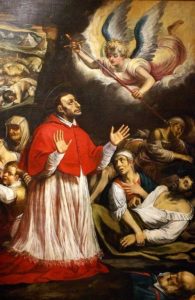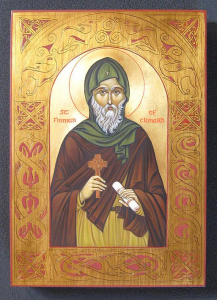 Saint Charles Borromeo
Saint Charles Borromeo
Archbishop of Milan (1538-1584)
Feast – November 4
The Villa d’Este is a 16th-century villa in Tivoli near Rome built by Ippolito (II) d’Este. It is famous for its terraced hillside Italian, renaissance garden and especially for its profusion of fountains, and is listed by the UNESCO (The United Nations Educational, Scientific and Cultural Organization) as a World Heritage Site.
Ippolito was born in 1509 in Ferrara, Italy, the second son of Duke Alfonso I d’Este and Lucrezia Borgia. In 1519, at the age of 10, he inherited the archbishopric of Milan from his uncle cardinal Ippolito d’Este. He is best known for his despoliation of Hadrian’s Villa built c. AD 120 by Roman Emperor Hadrian, removing marbles and statues from it to decorate his own. Milan had been the largest archdiocese in Italy, with more than 3,000 clergy and 800,000 people, but under the leadership of Cardinal Ippolito and previous archbishops it had deteriorated. Both its clergy and laity had drifted from church teachings. The selling of indulgences and ecclesiastical positions was widespread. Ignorance and corruption among the religious and disorder in monasteries was accumulating. On the 7th of February, 1560, Pope Pius IV appointed St. Charles Borromeo an administrator of the Archdiocese of Milan. On the 7th of December, 1563, he was consecrated bishop in the Sistine Chapel by Cardinal Giovanni Serbelloni, formally appointed archbishop of Milan on the 12th of May, 1564, after the former archbishop Ippolito II d’Este waived his claims on that archbishopric and made his formal entry into Milan on the 23rd of September, 1565.
St. Charles Borromeo, the third in a family of six children was born on the 2nd of October, 1538, in the castle of Arona on the edge of Lake Major, about forty miles from Milan. The Borromeo family was one of the most ancient and wealthy in Lombardy, made famous by several notable men, both in the church and state. The family coat of arms included the Borromean rings, which are sometimes taken to symbolize the Holy Trinity. His father Gilbert, Count of Arona was known for his almsgiving and rigorous fasts. His exceptionally virtuous mother Margaret was a member of the Milan branch of the House of Medici which produced four popes, Leo X, Clement VII, Pius IV and Leo XI, and two queens of France, Catherine de’ Medici and Marie de’ Medici.
St. Charles’s preferences in study made clear that he was destined for the ecclesiastical vocation. He received the tonsure when he was about twelve years old. His paternal uncle Giulio Cesare Borromeo, an abbot of Benedictine abbey of Sts. Gratinian and Felin turned over to him the revenues from the abbey to prepare him for a career in the church. Young St. Charles made plain to his father that all beyond what was required belonged to the poor and could not be applied to secular use. His father shed tears of joy, seeing his son’s kindness. He attended the University of Pavia, about 20 miles from Milan, where he applied himself to the study of civil and canon law. A slight speech impediment he compensated for with thoroughness, in effect he was able to make remarkable progress in a short time. In 1554 when his father died, sixteen-year-old St. Charles was requested by the family to take the management of their affairs. He resumed his studies, and on the 6th of December, 1559, twenty-one-year-old Charles earned a doctorate in canon and civil law. Nineteen days later his uncle Cardinal Giovanni Angelo Medici was elected as Pope Pius IV. The newly elected pope required his nephew to come to Rome. Shortly thereafter, on the 31st of January, 1560, the pope made him a cardinal, entrusted with both the public and the privy seal of the ecclesiastical state and appointed a supervisor of the Franciscans, Carmelites, Knights of Malta and on the 7th of February, 1560, he was assigned as an administrator of the Archdiocese of Milan. In the meantime, he was put in charge of maintaining delicate papal relations with other nations as the protector of Portugal and the Low Countries. All of these duties ordinarily require the prudence of mature years, but no one was disappointed by his services.
In Rome St. Charles was busy making reforms. He obliged the Roman Curia to wear black, established an academy of learned persons, clergy, and laymen, and published their memoirs as the Noctes Vaticanae. In 1561 he founded and endowed a college at Pavia, today known as Almo Collegio Borromeo, which he dedicated to St. Justina of Padua. He organized the third and last 1562–63 session of the Council of Trent, participated with authority in many of its twenty-five sessions and had a large share in the making of the Tridentine Catechism. Working for the splendor of God St. Borromeo lived in self-denial. His contacts with the Jesuits and the Theatines caused his faith towards a stricter and operative Christian life, eating only once a day and limiting himself often to bread and water. In 1562 his older brother, Federico, suddenly died. His family urged him to seek permission to return to the lay state, to marry and have children so that the family name would not become extinct, but he decided not to leave the ecclesiastic state.
On 7 December 1563 St. Charles was consecrated bishop and formally appointed archbishop of Milan. The urgency of the situation there persuaded the Pope to consent regretfully to his departure. The new Archbishop made his formal entry into Milan on the 23rd of September, 1565.
His aim was to put into practice the dignity and duties of the bishop as drafted by the recent Council of Trent. Believing that abuses in the church arose from ignorant clergy, he created seminaries to prepare future “saintly shepherds,” established schools and in general restored discipline in the Church of Milan.
He made numerous pastoral visits, and returned dignity to the divine service. He urged churches to be designed in conformity with the decrees of the Council of Trent, which stated that sacred art and architecture lacking adequate scriptural foundation was in effect prohibited, as was any inclusion of classical pagan elements in religious art. When someone suggested he should have a garden at Milan to get some fresh air, he replied that the Holy Scriptures should be the garden of a bishop. He divided the nave of the church into two compartments to separate the sexes at worship. He extended his reforms to the collegiate churches and monasteries.
Opposition to reforms grew among those who were seeking Milan as a place to enjoy oneself, to make money, and become clergy lacking discipline.
1576 was the year of crop failures in Milan, famine, and later an outbreak of the plague, a third of its citizens lost their lives. The Governor and many members of the nobility fled the city. The bishop remained to organize the care of those affected and to minister to the dying.
The magistrates governing the city placed their trust in human measures rather than divine ones and prohibited all the pious gatherings and processions. St. Charles was convinced that the epidemic was like the Roman Plague of 590, “a scourge sent by Heaven” as chastisement for the sins of the people, and saw spiritual measures, prayer, and penitence as most necessary to fight the plague.
Guided by the Divine Spirit he dedicated himself completely to assisting the sick and ordering public and private prayers. In the absence of local authorities, he organized the health services, founded or renewed hospitals, sought money and provisions, and decreed preventive measures. Unafraid of being infected, he in person would visit hospitals and lead penitential processions, being everything to everyone, like a father and true shepherd. While the pestilence spread, the St. Charles ordered three general processions to take place in Milan on the 3rd, 5th and 6th of October.
On the first day, he placed ashes on the heads of the thousands gathered, exhorting them to penitence, then the procession went to the Basilica of St. Ambrose. St. Charles led the people, dressed in purple, barefoot with penitential cord at his neck and large cross in his hand. In the church, he preached on the first lament of the prophet Jeremiah affirming that the sins of the people had provoked the just indignation of God. The second procession headed towards the Basilica of San Lorenzo. In his sermon, he applied the dream of Nebuchadnezzar indicating that the vengeance of God had come upon the city of Milan. The third day the procession went to the Basilica of Santa Maria at San Celso with St. Charles carrying a relic of Our Lord’s Holy Nail, which had been given by the Emperor Theodosius to St. Ambrose.
Then he ordered about twenty stone columns with a cross at the top to be erected in the main squares and city crossroads, allowing the inhabitants from every quarter to take part in the Masses and public prayers – from the windows of their homes.
At the end he persuaded the magistrates of Milan to reconstruct a crumbling sanctuary dedicated to the martyr and protector of Milan St. Sebastian and to celebrate a solemn feast in his honor for ten years. In July 1577, the plague and opposition to St. Charles’s reforms ceased. He wrote to the Governor, and successfully persuaded him to return. In September the founding stone was laid in the civic temple of St. Sebastian, where on January 20th every year, Mass is offered to recall the end of the scourge.
The holy Archbishop established schools of Christian doctrine, numbering in all seven hundred and forty, in which over three thousand catechists were employed, presiding over forty thousand students. In addition, he founded the fraternity of Oblates of St. Ambrose, a society of secular men who did not take orders but devoted themselves to the church and followed a discipline of monastic prayers and study while providing assistance to parishes at the same time.
Inflexible in maintaining discipline, to his flock he was a most tender father. He would sit by the roadside to teach a poor man the Pater and Ave Maria.
The sermons of Saint Charles produced great fruits among all ranks of the people. A man who admired him said that he always forgot the orator himself when he preached, so transported was he by the great truths he heard explained, and the longest sermons of Saint Charles seemed short to him.
As he lived, so he died on the 3rd of November, 1584, having governed his church for twenty-four years and eight months. To the heroic sanctity of this faithful copy of the Good Shepherd, many miracles came to testify, through his relics and his intercession. In 1602 Pope Clement VIII beatified him and in 1610 he was canonized by Pope Paul V.
References and Excerpts:
[1] F. Romana, “RORATE CÆLI: De Mattei: How St. Charles Borromeo braved the epidemic of his time,” RORATE CÆLI. https://rorate-caeli.blogspot.com/2020/03/de-mattei-how-st-charles-borromeo.html (accessed Nov. 19, 2021).
[2] “Saint Charles Borromeo, Archbishop of Milan.” https://sanctoral.com/en/saints/saint_charles_borromeo.html (accessed Nov. 19, 2021).
[3] “Charles Borromeo,” Wikipedia. Nov. 15, 2021. Accessed: Nov. 19, 2021. [Online]. Available: https://en.wikipedia.org/w/index.php?title=Charles_Borromeo&oldid=1055380180
[4] “Ippolito II d’Este,” Wikipedia. Feb. 14, 2021. Accessed: Nov. 19, 2021. [Online]. Available: https://en.wikipedia.org/w/index.php?title=Ippolito_II_d%27Este&oldid=1006790841
 Saint Finnian
Saint Finnian Saint Charles Borromeo
Saint Charles Borromeo